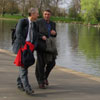Lichen Biomonitoring Protocol
 The method is adapted from Insarov (2002) to meet the additional requirements of an inter-city comparative study to record and
monitor lichen diversity and distribution in Moscow and London over a twenty-five year period.
The method is adapted from Insarov (2002) to meet the additional requirements of an inter-city comparative study to record and
monitor lichen diversity and distribution in Moscow and London over a twenty-five year period.
Changes in air pollution and climate over the period will also be documented to identify spatial and temporal trends.
A method for detecting long-term environmental change with lichens
- 1. Aim
- 2. Method
- 2.2. Site and plot selection
i. Sites should be carefully selected in each city. A short desktop study should be carried out to identify potential sites and reconnaissance visits should follow to ensure that adequate trees are present at each site. This preparatory work although time consuming is important to the long-term success of the project. Permissions to carry out survey work should be obtained from land owners.
ii. Parks in Moscow differ from London parks from a lichen monitoring perspective. There is undergrowth in most of the Moscow parks; hence light conditions for epiphytes are different from London parks. There are also fewer suitable parks in Moscow. It is suggested therefore that at least two park sites without undergrowth are selected as close to the centre of the city as possible taking into account limitations on tree species. Thereafter woodlands away from the city centre can be selected.
iii. There is a significant difference between lichen flora at exposed and shaded sites as well as woodland edge close to traffic flows and non-trafficked woodland edge (James & Davies 2006). These factors should be taken into account in the methodology. Therefore lichens should be recorded, following the recommended protocol, from the three site types – city centre parks, roadside woodland-edge and woodland. This will provide a greater indicator of ambient pollution impacts than central woodlands alone where pollution effects are at a minimum. Park plots should be selected at a distance 100 m or more from the traffic routes to avoid the direct influence of traffic.
iv. It is desirable to monitor from the same tree species as far as possible. Oaks (acidic) and limes/ash (neutral to basic) are suggested for this study but other, common tree species could also be recorded at the selected locations if time permits. The number of trees surveyed can be maximised and variation reduced if selected trees are of the same age/size and are located as close as possible to each other. Altitude, slope, aspect, shading, moisture and other factors known to affect lichen colonisation and development should be the same for all plots as far as possible (James et al, 1977).
v. The highest possible sampling within the time available should be attempted. This can be achieved by surveying the maximum number of trees within the survey area over a given number of days at each site. Three weeks have been allocated for sampling in London (15 working days). Three days will be used for reconnaissance and lab work and the remaining twelve days allocated to six sites. Two central London park sites will be selected and four woodland sites. Additional sites can be selected in both cities as time allows, but the basic 6 matched plots will form the base-line survey for the epiphytic comparative study.
- 2.3. Tree selection and lichen sampling protocol
- 2.4. Data collection and handling
- 3. References
Go back to the Biomonitoring page.

